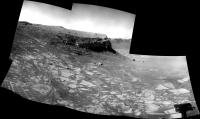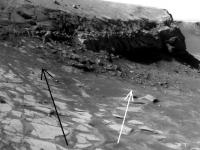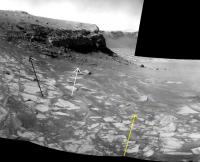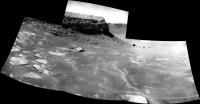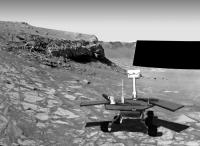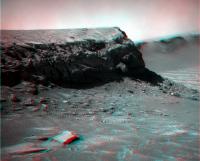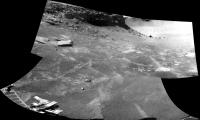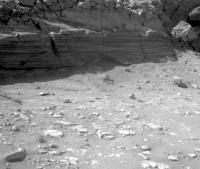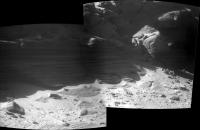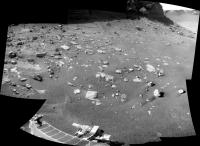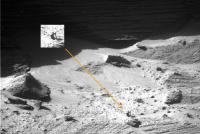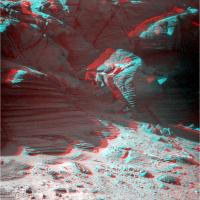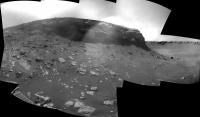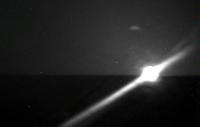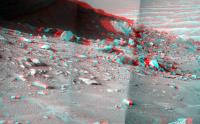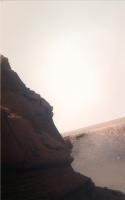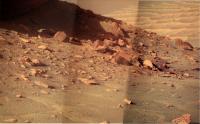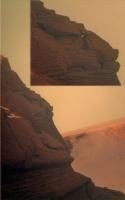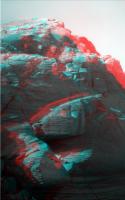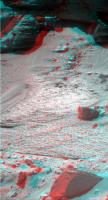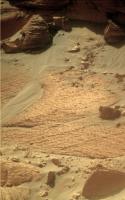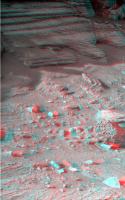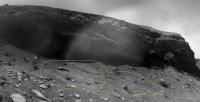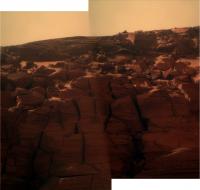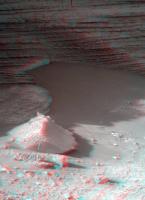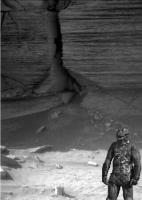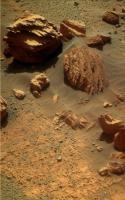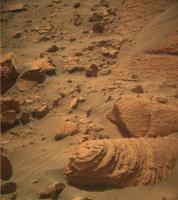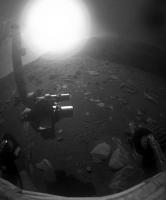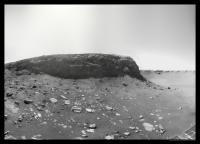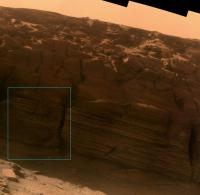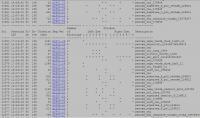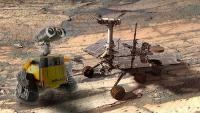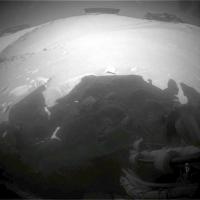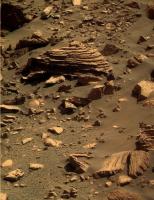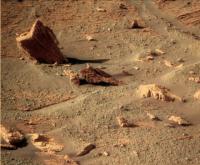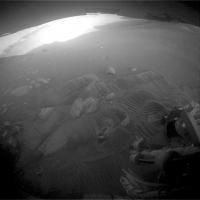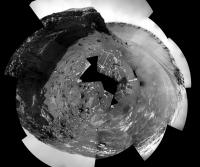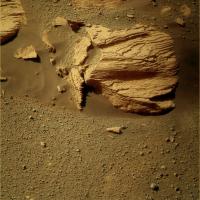Printable Version of Topic
Click here to view this topic in its original format
Unmanned Spaceflight.com _ Opportunity _ To the Cape! (part 2)
Posted by: Tesheiner Jun 13 2008, 08:10 AM
This is a navcam mosaic taken after driving during sol 1559.
Mmm, remember the name of this thread?
To the Cape! Yeah!
Posted by: MahFL Jun 13 2008, 10:38 AM
They are nice pictures. Makes a change to see something new after so many months.
Posted by: fredk Jun 13 2008, 03:16 PM
It's great to see us thoroughly out of the Quackmire! We now have a good view of potential approaches to Verde. Here's a crop from Tesheiner's mosaic. I've sketched two approaches that appear to stay pretty well on solid rocky surfaces. The black gets us close to the cliff, but not very deep - we've studied those layers already. The white route gets us deeper but not very close to the cliff. Of course they could continue past the end of the white arrow (that's where the original target lies), at the risk of getting bogged down again in loose soil...
Posted by: Tesheiner Jun 13 2008, 08:56 PM
Before the, mmm, "event", I thought Opportunity would move to a point that is after the white arrow. I think the terrain at that point is traversable enough to get the rover touching the wall.
BUT the situation now has changed. At least two new issues. imo. The first is obviously the fact(?) that moving up to the wall would mean getting stuck again on the way back. The second is that after this long time the shadows are getting bigger at Cape Verde.
Posted by: alan Jun 13 2008, 11:24 PM
Winter Solstice occurs in the southern hemisphere of Mars on June 26 so the shadows will soon start getting shorter.
Posted by: Tesheiner Jun 16 2008, 09:43 AM
Neither the black not the white path, Opportunity has followed the "yellow bricks".
Here's the current position plotted on the navcam mosaic from sol 1559.
And the latest view from tosol (1562).
Posted by: Astro0 Jun 17 2008, 06:56 AM
A lo-res SFX view based on Tesheiner's positioning.
Steady as she goes girl
Posted by: Tman Jun 17 2008, 07:50 AM
And overcomes sand traps again and chocks like this:
http://qt.exploratorium.edu/mars/opportunity/navcam/2008-06-16/1N266853834EFF9025P1815R0M1.JPG
Guess the two moved rocks is the spot where Oppy's middle wheel went stuck.
Posted by: Tesheiner Jun 17 2008, 10:11 AM
I was a bit afraid with the path they were taking now (the "yellow" one), but have a look to today's drive results and compare with yesterday images.
http://nasa.exploratorium.edu/mars/opportunity/forward_hazcam/2008-06-16/1F266853200EFF9025P1214R0M1.JPG Sol 1562 -> Sol 1563 http://nasa.exploratorium.edu/mars/opportunity/forward_hazcam/2008-06-17/1F266947878EFF9052P1214R0M1.JPG
They moved Opportunity downhill over the sand up to the isolated slab seen on the images then back uphill almost to the same spot as before. Looking to the wheel marks I fell that the terrain is much more stable then on the previous path where she got stuck.
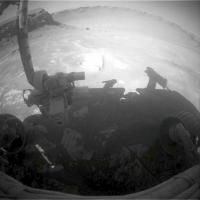
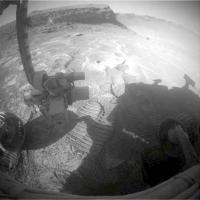
Posted by: climber Jun 17 2008, 11:21 AM
You may say that it's easy to say it now, but it seams they are driving the way I thought they will.
Rove straight down, back-up to be sure you can (back-up), and so on.
Once they are perpendicular and deaper to the place they want to meet the cliffs, they will do a ~80° + ~80° or so left turns and go up to the cliffs. Doing this, in case of been stuck, the'll can back up going down (on the same path) which will probably be much easier to get free. Any objection to this ?
Posted by: fredk Jun 17 2008, 02:53 PM
It does look like a successful toe-dip. After the quackmire, I'm still concerned about the sandy surface farther down. I wonder if they've been able to identify something about the appearance of the quackmire surface before we drove onto it that indicated it was dangerous. Or are they just trying again and hoping for the best...
Climber, it seems to me it's got to be risky to drive deeper than we need to...
Posted by: mhoward Jun 18 2008, 12:38 AM
That looks about right, Astro0. I was digging around in MMB for some views from other perspectives and found this one. The position based on the tracking data is only approximate, but actually it looks about right to me:
http://www.flickr.com/photos/marscat/2588917924/sizes/l/
Posted by: Tesheiner Jun 18 2008, 10:17 AM
We are getting closer!
This is from today's drive (sol 1564):
Posted by: fredk Jun 18 2008, 02:56 PM
And the maneuvering at the end of the drive shows we've still got good traction:
http://qt.exploratorium.edu/mars/opportunity/rear_hazcam/2008-06-18/1R267029709EFF9074P1312R0M1.JPG
Posted by: fredk Jun 19 2008, 03:32 PM
Another big drive downslope tosol (1565). The navcam view of Verde is now reminiscent of the previous best pancam views!
If we can make it across the scattered rocks immediately in front of us, it looks like a good, drivable rocky surface at the base of the cliff...
We're now by far at the deepest point we've ever been on this mission. I wonder if http://qt.exploratorium.edu/mars/opportunity/rear_hazcam/2008-06-19/1R267118367EFF90ADP1311R0M1.JPG that we're sitting on are original to this depth or tumbled down long ago.
Posted by: climber Jun 19 2008, 04:45 PM
We're gonna need your "man in black" for scale, Fredk !
Posted by: lyford Jun 19 2008, 09:02 PM
Sweet Fancy Moses! So nice to be moving again!
Posted by: Zeke4ther Jun 19 2008, 11:15 PM
This cliff structure reminds me of sandstones I saw in Colorado that were the reminents of old sand dunes.
Posted by: AndyG Jun 20 2008, 08:47 AM
Assuming the range is 16m or so, and our fredk is around 1.8m, I'd say something like this:
http://personal.strath.ac.uk/andrew.goddard/scale.jpg
Andy
Posted by: ngunn Jun 20 2008, 09:20 AM
Looks like the perfect spot for another picnic.
Posted by: peter59 Jun 20 2008, 09:37 AM
But it's very dangerous place.
We can find missing Miranda, Irma and Marion.
Posted by: peter59 Jun 20 2008, 09:58 AM
We are very near.
http://qt.exploratorium.edu/mars/opportunity/forward_hazcam/2008-06-20/1F267208016EFF90ARP1211R0M1.JPG
Posted by: Tesheiner Jun 20 2008, 10:45 AM
Now, look at THIS!!!
http://nasa.exploratorium.edu/mars/opportunity/pancam/2008-06-20/
Edited: Just 10 meters up to the wall!
Agree. It's time for another UMSF BBQ!
Posted by: jamescanvin Jun 20 2008, 10:59 AM
And that sequence is labelled as: pancam_drive_dir_L7R1 !!!
Amazing.
I was thinking the same about this being a nice spot for lunch.
James
Posted by: Tman Jun 20 2008, 12:45 PM
Looks like it's a popular place here - someone forgot his picnic basket ![]()
Posted by: mhoward Jun 20 2008, 01:08 PM
A few frames from an imaginary movie "zooming in" on the present position:
http://www.flickr.com/photos/marscat/2595377534/sizes/l/
http://flickr.com/photos/marscat/2595389036/sizes/l/
http://www.flickr.com/photos/marscat/2594542957/sizes/l/
http://www.flickr.com/photos/marscat/2595378250/sizes/l/
Posted by: lyford Jun 20 2008, 03:15 PM
http://en.wikipedia.org/wiki/Image:Baklava_-_Turkish_special%2C_80-ply.JPEG
It's really been a good week on Mars....
Posted by: Doc Jun 21 2008, 08:43 AM
I must say this is an impressive view of the Cape.(considering my pessimism for this drive)
However if they wish to get closer, i would recomend hard hats ![]()
Seriously, do we have to worry about falling rocks fro the cliff? ![]()
Posted by: fredk Jun 21 2008, 02:36 PM
Do you folks remember this http://www.unmannedspaceflight.com/index.php?showtopic=4097&st=0 If we do get a bit closer we may get a cliff http://www.unmannedspaceflight.com/index.php?s=&showtopic=4097&view=findpost&p=88189 afterall! ![]()
About falling rocks, we haven't seen anything come off any of the cliffs so far, but if she got close enough to do some grinding, who knows? ![]()
Posted by: ElkGroveDan Jun 21 2008, 02:52 PM
I am drooling at the prospect of seeing a nice clean RAT and MI of the lowest reachable layers.
I hope our skilled driver friends are back here on Earth practicing their ballet.
Posted by: Astro0 Jun 21 2008, 11:25 PM
Hmmm. Another BBQ. Yes, it has been some time.
I was hoping to do one around now, but the images I have of all of you just don't fit and wouldn't it be nice to include all the new faces since the last one over at HomePlate.
Perhaps this is something that we should discuss over at the Community Chit Chat thread.
My thought would be to wait until we have the mother-of-all-panoramas in colour first however.
Astro0
Posted by: Sunspot Jun 22 2008, 07:46 AM
What happened to yesterdays downlink? Or did they give the rover a day off?
Posted by: jamescanvin Jun 22 2008, 10:00 AM
No day off, there was a drive planned yesterday according to the tracking site. ![]()
I was waiting impatiently for data yesterday yesterday as well. But now we are so close to the cape the Odyssey passes are going to be a lot more restricted and I can imagine a few passes may be missed. Hoping to have my socks knocked off later today. ![]()
James
Posted by: peter59 Jun 22 2008, 12:37 PM
No comment !
http://qt.exploratorium.edu/mars/opportunity/navcam/2008-06-22/1N267294694EFF90B0P1980L0M1.JPG
http://qt.exploratorium.edu/mars/opportunity/navcam/2008-06-22/1N267397503EFF90B0P1982L0M1.JPG
http://qt.exploratorium.edu/mars/opportunity/navcam/2008-06-22/1N267294812EFF90B0P1980L0M1.JPG
Posted by: nprev Jun 22 2008, 12:48 PM
![]() ...well, there went my socks!
...well, there went my socks!
Posted by: jamescanvin Jun 22 2008, 12:49 PM
I think the front hazcam is my favourite ![]()
![]()
http://qt.exploratorium.edu/mars/opportunity/forward_hazcam/2008-06-22/1F267294323EFF90B0P1211R0M1.JPG
Posted by: ugordan Jun 22 2008, 12:50 PM
The second one is awesome, great contrast of light and dark!
Posted by: BrianL Jun 22 2008, 01:41 PM
Looks like a "toe dip" onto the scree (if that's the right name for this stuff). Seems solid enough. How close are they planning to get?
Brian
Posted by: mhoward Jun 22 2008, 03:21 PM
Funny, I was just doing the same thing. I don't think I've stitched anything in over a year. But since my stitch came out more or less the same (with one additional sky image), I'll offer this instead, and thanks to Doug hosting the file: http://mmb.unmannedspaceflight.com/Oppy1576VR.mov.
And I'll leave the stitching to James next time
Posted by: ElkGroveDan Jun 22 2008, 03:37 PM
Dang! That is sweet, Mike. Could you please go back and do that for every other spot we've parked at on Mars?
Posted by: Tesheiner Jun 22 2008, 05:19 PM
Did it too. What a view!
If they stop at this spot (I would prefer to go up to the wall, but shadow and UHF coverage might be a problem) the pancam mosaic (360 degrees pleeeeeaaaaaaasssssseeee!!!!) will be a hell of a view.
Edit: Just finished downloading Mike's VR shot, and I must agree with Dan.
Posted by: Aussie Jun 23 2008, 07:07 AM
Go Oppy! Take the limelight back from that 'Johnny come lately' at the pole. ![]()
Posted by: Stu Jun 23 2008, 12:07 PM
New http://qt.exploratorium.edu/mars/opportunity/pancam images are up...
http://qt.exploratorium.edu/mars/opportunity/pancam/2008-06-23
...but boy, they're a mess! If you hate lens flare don't go and look, it's everywhere, obliterating detail on the cliffs... and I think there are a few "sunrise" images too but they're very small...
Posted by: Bill Harris Jun 23 2008, 12:43 PM
What do you mean? The pancams of the cliff are exposed for the shadows, so the highlights are going to be overexposed, and with the dust-covered protective windows in sunlight, there is going to be a loss of contrast. Nothing that can't be processed out of the images.
Not optimum, but hardly a mess.
http://qt.exploratorium.edu/mars/opportunity/pancam/2008-06-23/1P266849270ESF9000P2445L7M1.JPG
http://qt.exploratorium.edu/mars/opportunity/pancam/2008-06-23/1P266849441ESF9000P2445L7M1.JPG
Posted by: Stu Jun 23 2008, 12:46 PM
Well, good luck "processing" something out of this...
http://qt.exploratorium.edu/mars/opportunity/pancam/2008-06-23/1P266849556ESF9000P2445L6M1.JPG
and this...
http://qt.exploratorium.edu/mars/opportunity/pancam/2008-06-23/1P266849695ESF9000P2445L5M1.JPG
![]()
Ok, point taken... some, not all, are a mess. ![]()
Posted by: brellis Jun 23 2008, 12:46 PM
After four+ years, my jaw still hangs open at what we're getting from these rovers!
Great QT, mike!
Posted by: fredk Jun 23 2008, 02:43 PM
Just to be clear, the newest of the new batch of pancams are from sol 1562 (apart from the solar filter shots), when we were much farther from the cliff than we are now. They were experimenting with exposures to try bring out detail in the shadows, which lead to severe bleeding from the sunlit areas. I have to say, I actually thought some of these heavily-bleeded images looked kind of cool, like http://marsrovers.jpl.nasa.gov/gallery/all/1/p/1554/1P266147134ESF89BAP2443R2M1.JPG
Posted by: Stu Jun 23 2008, 03:00 PM
Oh god, I can see Certain People claiming these are martian stromatolites or vegetation or something, and were deliberately airbrushed out of photos taken later...
Posted by: DEChengst Jun 23 2008, 04:05 PM
Three frame stitch:
http://paranoid.dechengst.nl/mars/are%20we%20there%20yet%20papa%20smurf.jpg (500 KB)
Looks like we'll need HDR imaging to get good results overall.
Posted by: mhoward Jun 24 2008, 12:24 AM
Yeah that overexposed stuff is from sol 1562 (seven sols ago). A few images came down from sol 1569, but all sky. Looks like we need to be patient.
P.S. Thanks for the comments on the QTVR. All I actually did was was export the frames from MMB and load the .pts file into PTGui. Whole process took a few minutes. Okay, I adjusted the image brightnesses first, which took a little longer.
Posted by: peter59 Jun 24 2008, 06:58 AM
I have great expectations.
Sol Seq.Ver ETH ESF EDN EFF ERP Tot Description
----- -------- --- --- --- --- --- ---- -----------
01570 p2265.06 40 40 0 0 2 82 pancam_cape_verde_10pts_L257R2
Posted by: fredk Jun 24 2008, 02:39 PM
One of the first closeup pancams, from sol 1570:
http://qt.exploratorium.edu/mars/opportunity/pancam/2008-06-24/1P267568307ESF90B0P2265L2M1.JPG
Lot's more to come! ![]()
Posted by: DEChengst Jun 24 2008, 03:47 PM
I truly suck at color correction™:
http://paranoid.dechengst.nl/mars/Cape%20Verde%20-%20false%20color%20-%20three%20frames.jpg (570 KB)
Posted by: Stu Jun 24 2008, 09:47 PM
... and I don't know about anyone else, but I'd be a bit worried about Oppy driving underneath something that looks this unstable...
Posted by: ElkGroveDan Jun 24 2008, 10:33 PM
Looking at that image I expect a coyote to come plumetting down on the rover and then an anvil to crash down on both of them.
Posted by: nprev Jun 24 2008, 11:10 PM
Yes...it is never safe to underestimate the reach of the evil Acme Corporation and its fiendishly persistent (though clumsy) field representatives... ![]()
Good point, though. I have no clue how stable these cliffs are. Come to that, we really don't have much of a clue as to the frequency & intensity of martian seismic events, though IIRC V2 didn't find much at all (V1's seismometer was inop, unless I got that backwards). The motion of Oppy shouldn't be enough to trigger anything by itself, though considering such effects in 0.38g combined with an utterly dry outcrop is kind of difficult...are ancient evaporites all that's holding this thing together besides compression?
Posted by: dvandorn Jun 25 2008, 04:17 AM
Although, you do have to admit that Acme has a very consistent track record -- and that record is, to be frank, abysmal. Therefore, you'd expect the Acme Mars Lander Wile E. Coyote would have to have used would not have gotten Canis Coyotus safely to the surface, much less anywhere near our beloved Oppy...
-the other Doug
Posted by: peter59 Jun 25 2008, 06:32 AM
I was slightly disappointed yesterday, but I have greater expectations today.
Sol Seq.Ver ETH ESF EDN EFF ERP Tot Description
----- -------- --- --- --- --- --- ---- -----------
01571 p2266.06 80 80 0 0 2 162 pancam_cape_verde_20pts_L257R2
Posted by: Stu Jun 25 2008, 02:39 PM
... and a couple more views before I head out to work... looking forward to seeing everyone else's efforts when I get back ![]()
Posted by: jamescanvin Jun 25 2008, 05:57 PM
Not much of tosols bit has come down, but most of yestersols has. ![]()
http://www.nivnac.co.uk/mer/index.php?title=b1570
(Click image)
James
Posted by: PaulM Jun 25 2008, 07:08 PM
James
I am really impressed by both stu's and james canvin's views of the strata exposed on the face of Capo Verde. For the first time details can be seen in the shadows. Now the geologists can get to work describing these beds which I think are stratigraphically below the Gibson band that Oppy RATed a few months ago. Am I correct in thinking that I can see lenticular bedding or am I just imagining it? Am I correct in thinking that some of the rocks on the slope are in situ and are therefore representative of an even lower stratum?
Posted by: ToSeek Jun 25 2008, 07:18 PM
I always think of the Acme Corporation when I see the Maas joke video of the RAT going into the rock and the rover spinning around. "If the Acme Corporation had developed the MERs."
Posted by: ElkGroveDan Jun 25 2008, 08:16 PM
Has there been any attempt to correlate the layers in Victoria to the layers identified in Eagle and Endurance craters? Was there any effort to follow the sequence(s) and surface layers with the APXS and Mossbauer data as Opportunity moved South? As I recall there was some ratting and integrating underfoot throughout the trip and in the exposures in Erebus.
Posted by: antoniseb Jun 25 2008, 09:15 PM
Opportunity's little Mossbauer unit must be pretty tired by now. It has a halflife of 3/4 year (roughly). So now, after about 8 half-lives, activity is down to a few parts per thousand of the initial strength.
Posted by: Tesheiner Jun 26 2008, 03:28 AM
There is a path in front of the rover which has a rocky ground almost at the base of the wall. That ground is layered, visible on both nav and pancams, and might be in situ.
Posted by: Stu Jun 26 2008, 03:18 PM
... and http://img.photobucket.com/albums/v509/cumbriansky/rocks3Db.jpg...
Posted by: Stu Jun 26 2008, 03:20 PM
... and http://img.photobucket.com/albums/v509/cumbriansky/rocks3D2s.jpg, too... lots of rocks Oppy, be careful now...
We have GOT to get a closer look at the jagged rock bottom left on http://img.photobucket.com/albums/v509/cumbriansky/spire.jpg image...
![]()
Posted by: Stu Jun 26 2008, 03:34 PM
Definitely one of my favourite post-entry http://img.photobucket.com/albums/v509/cumbriansky/spire-col.jpg...
Posted by: jamescanvin Jun 26 2008, 08:22 PM
Today's offering.
http://www.nivnac.co.uk/mer/index.php?title=opportunity-sol-1570-aamp-1571-l257-20-p-1
James
Posted by: fredk Jun 27 2008, 04:52 PM
Another sol, another spectacular set of pancams - here's one of my favourite views, in 3D:
Posted by: peter59 Jun 27 2008, 05:21 PM
My favourite views:
http://qt.exploratorium.edu/mars/opportunity/pancam/2008-06-26/1P267654659ESF90B0P2266L2M1.JPG
http://qt.exploratorium.edu/mars/opportunity/pancam/2008-06-27/1P267655553ESF90B0P2266R2M1.JPG
Looks like frames from old science fiction movie (Star Trek).
Posted by: jamescanvin Jun 27 2008, 06:14 PM
Just one image short of completing the sol 1570/1 bit now. It's becoming an amazing view! ![]()
![]()
Still this is only half of the total pan taken so far if you include those from sols 1572/3 that are still on the rover.
http://www.nivnac.co.uk/mer/index.php/opportunity-sol-1570-aamp-1571-l257-29-p
James
Posted by: dilo Jun 27 2008, 10:29 PM
Superb mosaic, James, even with dirt and unfilled rectangle...
Edit: Here I tried to reduce effects of dirt and glare in the half res version:
Posted by: algorimancer Jun 28 2008, 01:38 AM
The discontinuity between the thick central unit and the lower unit is interesting. Those lower layers seem to be at a significantly different orientation than in the upper.
Posted by: Juramike Jun 28 2008, 02:01 AM
Very interesting observation! Anyone got a possible explanation?
Posted by: nprev Jun 28 2008, 02:10 AM
Mmm...differential weathering? I've seen apparent discontinuities like this in the past on Earth; maybe the prevailing wind path around the two vertically separated regions is just different enough to cause the disparity. (I'm assuming that the whole formation is old, old, old...)
Posted by: Juramike Jun 28 2008, 03:40 AM
I'm wondering if we are seeing deposition, tilting of strata, erosion of upper section of tilted strata, then redeposition of upper layers of strata.
That would imply the lower layers are old, AND had an interesting history prior to the deposition of the upper strata.
-Mike
Posted by: Phil Stooke Jun 28 2008, 04:01 AM
No - much more likely to be just cross-bedding - i.e. cemented dune sandstones.
Phil
Posted by: Juramike Jun 28 2008, 04:23 AM
Phil
I thought cross bedding had little "wedgie" shapes?
Posted by: Bill Harris Jun 28 2008, 05:06 AM
At first glance it looks like truncated cross-beds or an unconformity, which is consistent with the aeolian dune-playa setting. We've seen this at several places in Endurance and Victoria. But if you look closely at the lower beds, you can see a fabric of essentially horizontal beds, morte or less parallel to the upper beds. So I'm thinking that one or the other orientation of the lower bed may be an artifact of aeolian erosion. We need an up-close look. We'll also be able to tell more once Oppy starts taking images out of the flat (shadowed) light.
Of more interest is the open fracture in the upper beds. Is it a solution cavity, or what?
Another example of the x-bedding is in 1P259578369EFF8900P2570L6M1.
--Bill
Posted by: Shaka Jun 28 2008, 05:55 AM
Ultimately, these questions all hearken back to the formation of the cape-and-bay crater rim. Why are the bays eroded down the strata at a 20 - 30 degree angle, while the capes are cut down more or less vertically. I can't believe that this is due to a more resistant sediment formation in the capes, neatly interspersed with less resistant strata in the bays. Until somebody lays out a plausible hypothesis for the formation of Victoria's sinuous rim, I don't think this little microcosmic curiosity at the base of one cape can be understood.
Posted by: ElkGroveDan Jun 28 2008, 07:31 AM
Primarily: Capes have greater exposure to the prominent erosion forces - prevailing winds. As a result they are in a less stable vertical condition. The bays are set back and more sheltered from the prevailing winds so they are older and have had time to slump. As an example go dig some holes in your yard, one each month. After a year see what the sides of the holes are like. The newest holes will have the steepest sides, the older holes will have slumped in on themselves.
Secondarily: The capes by virtue of their recessed shape are traps for the heavier particles that the winds are unable to lift from the crater.
This back and forth of capes and bays likely occurs in a manner analogous to a meandering stream. Over the eons the shapes will migrate back and forth as bays fill up and capes are eroded away...and the crater grows ever larger (assuming some external condition doesn't cause it to become filled in by migrating sand dunes or such.)
Posted by: PaulM Jun 28 2008, 08:21 AM
The problem with this argument if I understand it correctly is that the capes consist of ancient undisturbed strata and not the recent deposits you would see on the bank of a river. I think that the argument only works if Victoria crater is getting bigger at the same sort of rate that the capes are moving. Then there would always be a supply of fresh undisturbed strata from which to carve out the new capes.
Posted by: Bill Harris Jun 28 2008, 02:16 PM
Agreed, but I've not been able to wrap my brain around a plausible mechanism to explain the "scalloped" rim around Victoria (et al). With a couple of prevailing wind directions, there shouldn't be such symmetry in the scallops. I'm sure that the explanation is as simple as the ones covering stream meanders or salients and recesses, but I've not stumbled upon it.
--Bill
Posted by: centsworth_II Jun 28 2008, 02:22 PM
Concerning cracks and weathering around Victoria's rim, I wonder what effect the shock from the impact that caused the crater has. The blast must have left a pattern of disruption and cracks radiating for some distance that had an effect on future weathering.
Posted by: SteveM Jun 28 2008, 02:26 PM
My amateurish observation is that there is a broad lower band (just above the talus deposits) where the stratification is quite noticeable while on the band above that, the stratification is much less distinct. I'm assuming the whole wall were looking at was exposed simultaneously with the formation of the crater (or sometime thereafter). Two possibilities come to mind:
1. The level with marked stratification is made up of alternating strata of differing physical or chemical composition, and so the strata are eroded much differently which makes their differences strikingly visible.
2. The level with marked stratification has broader strata -- i.e., they were laid down in response to slower changes -- and so the erosion is more noticeable.
Comments from the experts are welcome.
Steve M
Posted by: ElkGroveDan Jun 28 2008, 04:06 PM
It's not true that the deposits on the banks of a river are necessarily recent. Rivers cut through some very, very old layers just as the wind on Mars is doing. Take a trip to the bottom of the Grand Canyon. There are entire banks in places made of Vishnu Schist which is 1.7 billion years old. The same is true the world over. In fact the best way to locate old layers is to examine the banks of a river (when there is no convenient road-cut nearby.)
Posted by: ElkGroveDan Jun 28 2008, 04:10 PM
Certainly radial fractures could create the seeds of an erosion pattern that might evolve into the resulting symmetry we still see after so many eons.
Posted by: Doc Jun 29 2008, 10:06 PM
The question of whether the pattern of the crater wall is due to the radial fractures produced by the impact or whether its because of other factors depends, I think, on the frequency of occurence of such craters with such exhibiting such a pattern.
If this 'Victorian spikes' design is particularly unusual for the region and we assume uniformity in the nature of the sedimentary rocks, one could be tempted to conclude that the impact is responsible for the pattern.
Another reason is because of a combination of the impact and nature of the rocks factors?
Is there another crater with such a pattern nearby?
Posted by: Juramike Jun 29 2008, 10:24 PM
From the abstract of a recent article discussing Victoria crater (see Nature of Victoria's Dark Streaks thread, post http://www.unmannedspaceflight.com/index.php?s=&showtopic=4081&view=findpost&p=119578):
"...sand [in Victoria Crater] is supplied from outside the crater and is presently escaping it's topographic trap. This process presents a possible explanation for the serrated margin of Victoria crater, through abrasion of the soft rock as trapped sands are blown out of the crater and carve alcoves under various seasonal winds."
What causes the regular spacing of the scallops? Good question. It could be from radial fractures from the crater formation (as centsworth II suggested), or it could be initiated from subtle turbulence effects as sand carrying winds swirl around the interior rim of the crater. It'd be neat to watch it evolve over time (a geologically long time, I reckon).
-Mike
Posted by: Shaka Jun 30 2008, 12:24 AM
Why is the rim shape so rare on Mars? Sand and wind and craters are everywhere; I'd wager the cape and bay shape is less than one in ten thousand. ![]()
Posted by: Bill Harris Jun 30 2008, 12:46 AM
I've seen other examples in HiRISE images of scalloped craters, I ought to dig through and catalog similar crater-forms. Ugh.
At one time I speculated that the radial scalloped rim was due to the Anatolia Features, which were originally seen near Eagle-Endurance craters and are presumably concealed under the dune-sand south of the type area, and have been noted near the southeast rim of Victoria.
Attached is an image showing the trends of the Anatolia Features and also the trends of Victoria's scalloped rim (I don't recall if it's mine, I might have purloined that Victoria image from a post). You can see similarities, but you'd need to run stats on the trends to make sense.
Presented FWIW.
---Bill
Posted by: Juramike Jun 30 2008, 12:48 AM
Maybe the underlying strata that Victoria impacted are atypical?
[EDIT: Just saw Bill Harris' post. I KNEW we shoulda spent more time at Anatolia!]
Posted by: Shaka Jun 30 2008, 02:46 AM
We thrashed this one around during the trek south to Victoria. Some of us tried to apply the hypothesis that Meridiani craters had been buried and later exhumed.
But buried/exhumed craters are not likely as rare on Mars as cape-and-bay rims.
I tried to imagine a crater that filled with water while it was still hot, then froze and was buried. It was later exhumed, and, meanwhile, collapsed as the ice sublimated.
I've not yet seen any clear evidence to back this scenario. ![]()
I keep waiting for the paper that makes Vikky comprehensible.
Posted by: Bill Harris Jun 30 2008, 02:58 AM
Anatolia was one of the first of many wonder that Oppy came across after emerging from Eagle crater. At the time we prioritized the 90-day operational life of the rover, so it was reasonable that we didn't spend an inordinate amount of time there. And, short of having a track-hoe along to do serious excavation, I don't know how much could have been gained beyond Pancam views. I do wish we'd been able to have inspected a few more Anatolia Features on the traverse southward. If we do continue the traverse around Victoria, we ought to look at the Anatolia Feature that is intersected by the southeast crater rim.
My initial, and continuing, impression of the Anatolia Features is that they are solution cavities along joints (or rather, a joint system intermittently widened by solution cavities). That is, until more evidence comes our way...
--Bill
Posted by: ngunn Jun 30 2008, 09:23 AM
Well I had a go at explaining the capes and bays way, way back. I think it was my first venture into a Mars topic. Anyhow there are new people here now and the idea has never gone away so here it is once more.
I think there was an uneven layer of water-rich material below the presently exposed strata and that this was fluidised by the Victoria impact. This resulted in selective sapping and collapse of the original crater walls, leaving vertical cliffs untypical of impact craters (but frequently produced on Earth by undermining and removal of material). Much of the fluidised material would have ponded in the centre of the crater and subsequently wasted away by sublimation and wind erosion. There are a number of possibilities for the easily fluidised water-rich layer, including some recently proposed highly hydrated martian minerals, for which I'd have to hunt a bit for the reference.
Why so rare? You need an impact to occur bang on top of one of these super-hydrated deposits, located at just the right depth relative to the size of the impact.
OK folks, shoot it down (EDIT: or ignore it) all over again!!
Posted by: briv1016 Jul 1 2008, 05:02 AM
No new images since Friday. Is something going on? ![]()
Posted by: Tesheiner Jul 1 2008, 06:32 AM
Images are being downlinked everyday but there might be a problem in the pipe between JPL and the public sites.
Not the first neither the last time it will happen.
Posted by: Astro0 Jul 1 2008, 06:50 AM
Both Canberra and the Madrid DSN stations have MER1 Opportunity tracking passes scheduled this week.
We have one 65 minute pass happening just a few hours from now between 8.55-10.00 UTC.
It's an uplink, with a radio science downlink ("beep").
I agree with Tesheiner...not an unusual matter for there to be no updates over the 'weekend'.
Be patient, I'm sure our girl is OK.
Astro0
Posted by: jamescanvin Jul 1 2008, 07:24 AM
Yes, don't worry, the data is arriving in the tracking database as normal. As Tesheiner says, just a problem with the system that gets the images out to us, it's happened many times before. Jim needs to give something a kick. ![]()
To put your mind at ease here is a stamp from yestersol (1576) off the tracking site. ![]()
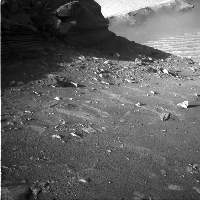
James
Posted by: Tesheiner Jul 1 2008, 08:15 AM
Just found this entry on an http://www.space.com/scienceastronomy/080630-opportunity-mars-cliff.html. Nothing really new but it's good to know they are still sticking to the plan of touching the wall.
"Whether we'll be able to accomplish this or not, though, we don't know," Squyres added. "The terrain here is very steep, and we obviously don't want to venture so close to the cliff that we're in its shadow. So we'll see."
Posted by: Juramike Jul 1 2008, 04:21 PM
If the joints were created or modified by solution it seem reasonable to hope that there might be evidence of deposits at the rock-atmosphere interface. Who knows? Maybe some of the rocks that previously lined the cracks in Victoria crater and then tumbled out will have some type of deposit visible?
I think it would be really cool to stick Oppy's arm deep into one of the accessible cracks and get an APXS and Mossbauer measurement to compare with the "normal" exposed cliff face. That might furnish a hint of underground solution transport since the crack formed.
"Put your hand in the box...."
-Mike
Posted by: djellison Jul 2 2008, 11:30 PM
There's a burp in the imagery pipeline somewhere obviously - the people that need to know, now know.
Posted by: TheChemist Jul 2 2008, 11:54 PM
-Mike
I gather we 'll have an APXS of spice soon ...
Posted by: DFinfrock Jul 3 2008, 03:26 AM
At the other end of the planet, I sure hope Phoenix's scoop isn't mistaken for a thumper.
Posted by: Tesheiner Jul 3 2008, 06:43 AM
I just hope it's solved soon, otherwise we'll probably be without the daily MER "fix" until after the US holidays.
On a different topic, I just checked the planned sequences to find that Opportunity is scheduled to move on sol 1582; that will be this sunday.
To the Cape!
Posted by: peter59 Jul 6 2008, 09:52 PM
Exploratorium is Back Up. Woo hoo!!
Posted by: Floyd Jul 6 2008, 10:02 PM
peter59 you just beat me to it. I was starting to think of the old "If a tree falls in the forest and no one hears it..." as applied to spacecraft: Does a spacecraft exist if UMSFers don't see the relayed pictures? Spirit and Opportunity were fading like the Cheshire Cat--not gone, but just starting to fade. ![]()
Posted by: djellison Jul 6 2008, 10:39 PM
The blockage is free, but there;s a backlog we're missing. Hopefully it will filter thru.
Posted by: fredk Jul 6 2008, 11:15 PM
Really good to see fresh pics again. It looks like tosol's (1582) drive was a short drive away from Verde:
http://qt.exploratorium.edu/mars/opportunity/forward_hazcam/2008-07-06/1F268625298EFF90B2P1213L0M1.JPG
Posted by: Tesheiner Jul 7 2008, 10:03 AM
> The blockage is free, but there;s a backlog we're missing. Hopefully it will filter thru.
I hope so. There're a lot of "juicy" pictures on this missing batch: Half of the latest mosaic and the whole superres shots.
Posted by: peter59 Jul 7 2008, 03:50 PM
Time for harvest !!!!
http://qt.exploratorium.edu/mars/opportunity/pancam/2008-07-07/
Posted by: djellison Jul 7 2008, 04:29 PM
Reading http://nasa.exploratorium.edu/mars/opportunity/pancam/2008-07-07/... scanning... found 410 new images.
Yeah - that oughtadoit ![]()
Doug
Posted by: Stu Jul 7 2008, 04:33 PM
Oh wow.... seriously, how beautiful a world is this, when it can show us such wonders as these...
Even better in http://img.photobucket.com/albums/v509/cumbriansky/1P267829974ESF90B0P2268L2M1-3D2.jpg...
... and http://img.photobucket.com/albums/v509/cumbriansky/1P267829736ESF90B0P2268L2M1-3D.jpg one too...
... and another shard like http://img.photobucket.com/albums/v509/cumbriansky/shard2b.jpgisn't something Oppy wants to be under when it crumbles and falls off the cliffside, is it?!?!
Posted by: CryptoEngineer Jul 7 2008, 07:17 PM
I hope Oppy spends some time examining these fallen blocks - they are samples delivered
from parts of the cliff we can't reach directly.
ce
Posted by: nprev Jul 7 2008, 09:02 PM
![]() ...shee-yit...
...shee-yit...
Mind-blowing is all, Stu, thank you!!! Burning question is how such apparently delicate blade-like extrusions could survive a fall from the cliff. Is it due to the gentle gravity, or did they grow out later from atmospheric precipitates? Either possibility seems extraordinary. The third is selective weathering, which would imply significant compositional differences between layers...again, very, very interesting, and difficult to explain in detail without better data on past conditions.
What a site! ![]()
Posted by: Juramike Jul 7 2008, 09:09 PM
I wonder how friable the exposed rocks are?
Those rocks in the images Stu posted look like they've been windblasted and eroded to the point like they are fine layers of phyllo dough ready for baklava.
One gentle push and they'd all go *poof*....
('Course, they survived the impact when they fell OK). How come we don't see more chunks? Did these bounce to their present position?
It's kinda hard to tell, but it looks like they got eroded before they fell away from the cliff. But the horizontal layering on the perpindicular rock in the image looks suspect.
-Mike
[EDIT: Ha! Nick beat me to it with the erosion questions!]
Posted by: fredk Jul 7 2008, 09:22 PM
My impression, for what it's worth, was that it's been a long time since they fell. They may have been much larger when they fell, and this is all that's left after millenia of wind erosion.
Posted by: Ant103 Jul 7 2008, 09:30 PM
Yeah - that oughtadoit
Doug
Really … big
Here is a preview of a part of the upcomming big pan of Cape Verde
http://www.db-prods.net/blog/wp-content/uploads/2008/07/sol1570-capeverde-panoramabeta-medres.jpg
Stu : your anaglyphs are astounding.
Posted by: Juramike Jul 7 2008, 09:45 PM
So the question is: If these blocks down here have fragile exposed sheet-like structures after being eroded by wind, shouldn't the cliff faces also have fragile sheet-like structures?
Are they in the same erosion environment?
Or are the cliff faces too high to have been subjected to millenia of bouncing grains. Maybe the foot of the cliff will have these??
Posted by: Stu Jul 7 2008, 10:42 PM
Thanks, that means a lot coming from one of our foremost Imagemages...
Here's http://img.photobucket.com/albums/v509/cumbriansky/1P267829226ESF90B0P2268L2M1-3d-s.jpg...
Posted by: fredk Jul 7 2008, 11:05 PM
I think you can see them at the foot of the cliff in some places, like near the left side of the image I added to http://www.unmannedspaceflight.com/index.php?s=&showtopic=5242&view=findpost&p=119407
Posted by: jamescanvin Jul 7 2008, 11:34 PM
Completed pan of Cape Verde, what a view! ![]()
http://www.nivnac.co.uk/mer/index.php/opportunity-sol-1570-aamp-1578-l257-54-p
James
Posted by: Stu Jul 7 2008, 11:45 PM
That's gorgeous James, absolutely gorgeous...
One final close-up of the luvverly, luvverly layers before I head off to bed... up again in 5 hrs... ![]()
Posted by: Juramike Jul 8 2008, 02:44 AM
Beautiful work, James!
I just spent some time slowly panning back and forth across your full res image....Imagining trying to climb the cliffs, looking for handholds and foot holds, maybe whipping out a rock hammer and chipping at some layers.
Your mosaic really brings Mars closer!
Posted by: Juramike Jul 8 2008, 02:46 AM
Oh yeah!! And looking at the big mosaic it looks like the lower sets of layers really got eaten into by the wind.
Curious to know if those particular layers are softer, or just lower to the ground and more accessible to saltating sand.
Posted by: Shaka Jul 8 2008, 04:50 AM
28.2% of one, and 71.8% of the other. ![]()
The blocks among the scree are almost certainly not from the bottom of the exposure.
Posted by: CosmicRocker Jul 8 2008, 05:47 AM
One of the latest tau images from sol 1583 apparently captured a local sunset. It doesn't appear to be a transit of one of the moons. Its description was "late tau," so I assume it must be a view toward the west. Apparently its metadata is not yet available, because I can't find it in MMB's sol 1583 panorama.
I assume this shadow must originate somewhere on Victoria's western rim. It would be fun to discover exactly where the sun set from Opportunity's viewpoint at the time. ![]()

Posted by: Tesheiner Jul 8 2008, 06:43 AM
Here're the info from the pancam web: az=-63.7671, el=-12.5.
Posted by: HughFromAlice Jul 8 2008, 12:12 PM
James, what a truly amazing view of Cape Verde and how excellent your work is! It exemplifies the high standard of UMSF and how much you guys passionately love what you are doing.
Since Oppie is my sentimental and scientific favourite, it's appropriate for me to make my first post here. I'll be posting from time to time - when I have something useful/interesting to add. (+I'm very very busy running my own business!) My formal background is psychology but I have wide ranging interests.
I'm from Alice Springs in Central Australia where the Milky Way is awesome to behold in the cold clear nights of winter. If any of you UMSFers happen to be passing through such a remote place as Alice then feel free to contact me through this forum for some Centralian hospitality and a few good pointers on great places to visit.
Posted by: elakdawalla Jul 8 2008, 12:47 PM
I'm a bit lost -- can we assume that Oppy now significantly closer to the cliff than it was on http://www.unmannedspaceflight.com/index.php?s=&showtopic=681&view=findpost&p=118923?
Well caught on that sunset -- that's pretty neat.
--Emily
Posted by: jamescanvin Jul 8 2008, 12:54 PM
We backed off just a touch on 1582 (a matter of inches)
But tosol (1584) is another driving sol so Oppy should be on the move in the next few hours. ![]()
James
Posted by: nprev Jul 8 2008, 02:05 PM
Just remarkable work, James; congratulations! Why do I feel another UMSF AW&ST cover coming on?
Stu, I am going to find some new 3D glasses as soon as I'm off @%&# nights this week, I swear!!! (Just got home after almost 14 hrs of joy, here...)
I'm not even a geologist, but I'd probably give ten years of my life to spend just a week here with a rock hammer and a hand lens.
Posted by: Ant103 Jul 8 2008, 02:06 PM
James, you're really fast ![]() What is you secret
What is you secret ![]() ?
?
So, I'm not as faster as James ![]() but here is a quick view of this big pan, not blended, only in L2 :
but here is a quick view of this big pan, not blended, only in L2 :
http://www.db-prods.net/blog/wp-content/uploads/2008/07/panol2-quickview.jpg
The next step will be coloration ![]() .
.
Posted by: jamescanvin Jul 8 2008, 03:12 PM
Many years of writing a stupidly complex program to do a lot of the hard work automatically - oh and what time did I post that pan, half past midnight!
Good luck with your version!
James
Posted by: TheChemist Jul 8 2008, 03:19 PM
Many thanks James and Stu ! ![]()
I don't know about you guys, but for my eyes the 3D images Stu posts happen to be the most realistic ones I've ever seen.
Stu, please keep them coming !
And as a bonus ..... there is a small abyss in the left of the cape :-)
Posted by: fredk Jul 8 2008, 05:19 PM
http://www.greuti.ch/oppy/html/filenames_ltst.htm gives just after 5pm local time for that image (as anyone who's lived in the mountains knows well, apparent sunset can be well before "true" sunset, when the sun hits zero degrees elevation). If that azimuth of 64 degrees is right, I think that point is off the left edge of the new pancam mosaic.
Did you guys notice that the corresponding R8 image to that L8 sunset shot is empty (1x1 pixel)? Apparently the parallax between left and right cameras meant that the sun had already set for the right camera, and so the solar auto-cropping routine just returned an empty image. If you were looking at the rover at the time those images were taken, you'd see the shadow of Verde bisecting pancam, with the right camera in shadow and the left in (partial) sun.
Posted by: Stu Jul 8 2008, 06:20 PM
Stu, please keep them coming !
Wow, thanks, I really appreciate that. I just realise that there's No Way I can produce panoramas as good as others here, but I have got quite nifty at making 3D pics and colourised crops, so I limit myself to those now. I love being able to look into a 3D image and imagine reaching into it, through the screen, across all those millions of kilometres, and wrapping my hand around the rock, feeling its rough edges even through the thick material of my spacesuit glove, feeling the weight of it as I lift it off the ground and see the talcum-fine martian dust hissing and trickling off it before holding it up in front of my visor and turning it round and round, wondering and marvelling at how long it's sat there, inside Victoria Crater... it's just the most amazing feeling...
Posted by: Gonzz Jul 8 2008, 08:01 PM
Gorgeous work James, thank you very much
It's a beautiful cape, a rocky whale cresting over a waterless sea
Posted by: Tesheiner Jul 8 2008, 11:07 PM
And here we go, up to the wall.
Nice flare on the camera.
http://qt.exploratorium.edu/mars/opportunity/forward_hazcam/2008-07-08/1F268806270EFF90B8P1213R0M1.JPG
Posted by: TheChemist Jul 8 2008, 11:45 PM
Fingers crossed. The sand looks very soft ![]()
Posted by: ilbasso Jul 9 2008, 02:21 AM
I think these views are easily the most dramatic from Oppy since she was aside Burns Cliff way back in December 2004.
You've come a long way, baby!
Posted by: Astro0 Jul 9 2008, 06:22 AM
Fantastic James! I can't wait until Opportunity gets a chance to 'touch' the wall.
Here's my artist's view of this iconic mission image.
I'm looking for a place to post the 19mb version.
Enjoy
Astro0
Posted by: Stu Jul 9 2008, 08:18 AM
Astro0
Alright you two, stop it, just STOP it! How are we meant to get any work done when you create masterpieces like that?! I've three big editing jobs on the go, talks to arrange, and then my day job to go to later, and you serve me up THAT to wander around and drool over!!! I can't stop scrolling around it, looking at all those lovely layers and beautiful boulders... Cruelty beyond measure!
Posted by: Oersted Jul 9 2008, 12:37 PM
Will we have a chance at some point of seeing the cliff face out of shadow? It is a magnificent panorama, but the lighting isn't exactly optimal.
Thx to all image contributors!
Posted by: jamescanvin Jul 9 2008, 01:05 PM
The cliff faces almost due south, so at this time of year (southern midwinter) it is essentially permanently shadowed. Oppy would have to wait for summer to get a non shadowed shot and I think we'll be long gone by then.
James
Posted by: ngunn Jul 9 2008, 03:29 PM
Could there be an advantage in being in shadow? A more even illumination will play down the topography of the rock surface for sure, but that could make it easier to observe other features such as differences in colour and grain size.
Posted by: fredk Jul 9 2008, 04:19 PM
From http://marsrovers.jpl.nasa.gov/mission/status_opportunityAll.html#sol1566
As spring approaches, we'll be able to get closer to the cliff, but that will be a very slow process...
As far as imaging the cliff in full shadow, they did this very late in the afternoon on sols 1579 and 1580, using the open L1 filter setting to let in as much light as possible. Some of these shots show incredible detail:
http://marsrovers.jpl.nasa.gov/gallery/all/1/p/1579/1P268378611ESF90B0P2270L1M1.JPG
http://marsrovers.jpl.nasa.gov/gallery/all/1/p/1580/1P268467062ESF90B0P2271L1M1.JPG
http://marsrovers.jpl.nasa.gov/gallery/all/1/p/1580/1P268467243ESF90B0P2271L1M1.JPG
http://marsrovers.jpl.nasa.gov/gallery/all/1/p/1580/1P268466438ESF90B0P2271L1M1.JPG
Posted by: brianc Jul 9 2008, 06:26 PM
Stunning photo James - I think it's about time Mr Squyres had a feature named after him as he has got to be the king of Mars Geology
how about a vote for 'Squyres Cliff' - a fitting tribute to SS & team
Posted by: Roby72 Jul 9 2008, 07:12 PM
As my understanding is - the shadow of the cliff (and therefore low solar energy) will prevent Oppy from doing lots of interesting work with its IDD ??
Other problems could also prevent it - unpassable terrain for example. How good are the chances to reach the cliff ?
Robert
Posted by: fredk Jul 9 2008, 09:31 PM
From the http://marsrovers.jpl.nasa.gov/mission/status_opportunityAll.html#sol1574
Anyone hazard a guess as to which rock is Nevada?

Posted by: vikingmars Jul 9 2008, 10:09 PM
Here's my artist's view of this iconic mission image. I'm looking for a place to post the 19mb version. ![]()
Enjoy Astro0 [/quote]
![]() Astro0, your image is just incredible and so beautiful !!!
Astro0, your image is just incredible and so beautiful !!!
Well... I'm so sorry to arrive "after the battle" with only a black & white Navcam (calibrated and cleaned) version...
Anyway... I hope you will enjoy it ! ![]()
Posted by: ilbasso Jul 10 2008, 12:37 AM
Anyone hazard a guess as to which rock is Nevada?

This one, mebbe?
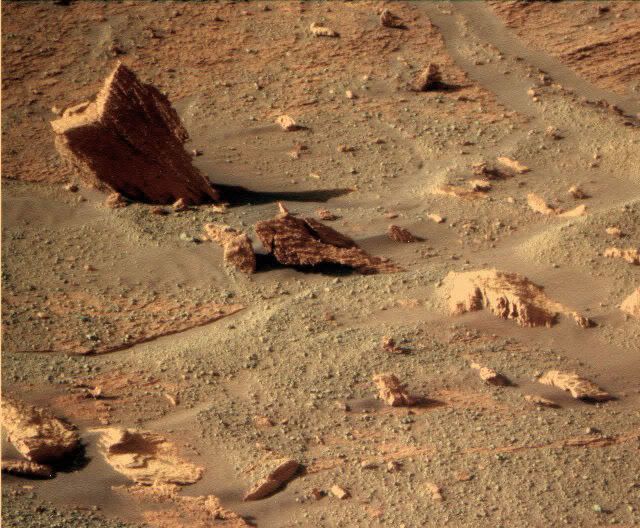
Posted by: nprev Jul 10 2008, 01:00 AM
Yeah...been looking at that one for awhile, now. If I found that on Earth, first things I would think of are 1) gypsum crystal, 2) aragonite, 3) sand-encrusted exotic silicate, like kunzite. The truth is probably far more mundane, but if it is in fact any of these minerals then there had to be considerable water present to form it at all way back when.
Posted by: Aussie Jul 10 2008, 01:14 AM
I was wondering if it wasn't the bedrock closer in here:
http://marsrovers.jpl.nasa.gov/gallery/all/1/p/1580/1P268467243ESF90B0P2271L1M1.JPG
Right shape, but I guess a bit close in
Posted by: edstrick Jul 10 2008, 09:01 AM
"Could there be an advantage in being in shadow? ..."
Yes, but. If the camera lenses were spotlessly clean, diffuse illumination would indeed have advantages. Only with the sun close enough to the field of view to cause actual lens-flares that interfere with visibility in the diffusely illuminated shadow would there be a problem. Unfortunately, post-dust-storm, the lenses are very un-clean.
When all else fails, and you think youi're going blind...... CLEAN YOUR GLASSES.
Unfortunately, the rovers can't.
Posted by: ngunn Jul 10 2008, 09:30 AM
Thanks for that reply, but can you clarify something for me. What is the main problem with the dust on the lenses when it comes to taking shots in the cliff shadow specifically? Is it:
1/ simple obscuration causing too-low light levels in the camera, or
2/ interference from light scattered by the lens dust washing out the darker parts of the scene?
If the former there's not much to be done I suppose. But if it's the latter? Presumably it's normal to arrange for the lenses not to be in direct sunlight, and presumably indirect illumination of the lens dust will decrease the closer in we get to the shadowed cliff, so maybe the shadow images will get progressively better for that reason??
Please correct me if I'm hopelessly off-track.
Posted by: edstrick Jul 10 2008, 10:54 AM
"...What is the main problem with the dust on the lenses when it comes to taking shots in the cliff shadow specifically? Is it:
1/ simple obscuration causing too-low light levels in the camera, or
2/ interference from light scattered by the lens dust washing out the darker parts of the scene? "
I presume it's mostly the latter, though when dust on lenses was recently recent additions, and the camera looked up at relatively featureless sky, you could actually see out of focus globs of dust on the optics as shadows. When it's thick enough, it obscures light, and diffusely transmits it like Titan's atmosphere. But mostly, it's like driving toward the sun 20 min from sunset with a dirty windshield. Unfortunately, with the sun on the north side of the sky, it's the worst case, and its scattered glare is hard to avoid except in early morning or late afternoon, not the best time of day power-wise <regardless of other operating constraints> of the rovers.
Posted by: djellison Jul 10 2008, 10:55 AM
Camera in shadow, means rover in shadow, means a big hit on Whrs.
The recent 4.30pm dusk panorama though, is an example of what can happen to help.
Doug
Posted by: edstrick Jul 10 2008, 11:01 AM
"Camera in shadow, means rover in shadow, means a big hit on Whrs"
Bet you get cold, fast, too!
Posted by: djellison Jul 10 2008, 11:11 AM
You get cold at night anyway ![]()
Posted by: ugordan Jul 10 2008, 12:01 PM
Would it really get that cold in the shadow and fast? I take it the rarefied martian air sucks at conduction and convection so the primary means of losing heat would be radiation. The rover's not that hot in the first place, so radiative cooling ought to be slow, no?
Posted by: ngunn Jul 10 2008, 12:15 PM
If it's within the cast shadow of the cliff, yes. But if the camera's pointed NW in the morning or NE in the afternoon it should be sufficiently far from the solar azimuth to keep direct sunlight off the lens, no? Your post suggests that something like this tactic is already being adopted.
I suppose as the sky fills a smaller and smaller solid angle as seen by the lens you get down to a limiting situation where most of the remaining illumination of the lens dust is coming from sunlit parts of the rover itself. I'm not familiar enough with the rover geometry to know how significant that would be.
Anyhow, the pictures so far have been truly spectacular. Congratulations to the rover team, and thanks too for all the great processed images posted here. What a party!
Posted by: fredk Jul 10 2008, 03:42 PM
One additional problem to add to ngunn's list is ccd bleeding. If you're trying to image shadowed areas of the cliff, and there are adjacent sunlit areas or sky, you can get severe bleeding ruining the image if you expose for the shadowed areas.
That reminds me: I assume you're talking about the sol 1579/80 L1 sequences. Using the rawid utility (which I found on these pages in the distant past), the 1579 sequence went from about 16:35 to 16:50 local time, and 1580 was about 15 minutes earlier.
But using http://www.greuti.ch/oppy/html/filenames_ltst.htm I get considerably later times: 17:45 to 18:00 on 1579 (and again 15 minutes earlier on 1580). My assumption is that rawid has gotten well out of synch, and that Tman's decoder is much closer to the truth. Can anyone clarify this?
If 18:00 is correct, that would definitely be after sunset for Oppy considering that she's in a hole, since even out on the plains the sun would set a bit before 18:00 local solar time near the winter solstice.
Posted by: Ant103 Jul 10 2008, 04:18 PM
Hi
It was hard, long, but I finally "succed" to make this huge panoramic view of Cape Verde (there already are some vignetign and flares, in spite of my efforts ![]() ).
).
Various resolution can be found at the end of this page (summer page because of impossibility to update my webstite):
http://www.db-prods.net/blog/?page_id=151
And I've made two desktops, one for 4:3 screens, and other for 16:9.
http://www.db-prods.net/blog/wp-content/uploads/2008/07/capeverde-sol1570-desktop-1280.jpg
http://www.db-prods.net/blog/wp-content/uploads/2008/07/capeverde-sol1570-desktop-1440.jpg
So, time to have a break ![]() .
.
Posted by: jamescanvin Jul 10 2008, 04:40 PM
Here it is.
http://www.nivnac.co.uk/mer/index.php/cv_astro0
James (on behalf of Astro0)
Posted by: Tesheiner Jul 10 2008, 09:30 PM
But using http://www.greuti.ch/oppy/html/filenames_ltst.htm I get considerably later times: 17:45 to 18:00 on 1579 (and again 15 minutes earlier on 1580). My assumption is that rawid has gotten well out of synch, and that Tman's decoder is much closer to the truth. Can anyone clarify this?
From the pancam web I get 17:38 for the first picture in the 1579's sequence and 17:55 for the last one.
Posted by: fredk Jul 10 2008, 10:34 PM
Thanks, Tesheiner. So it seems Tman's filename decoder agrees with pancam web to 5 minutes or so, which is very good. Also, http://www.unmannedspaceflight.com/index.php?s=&showtopic=4427&view=findpost&p=96780 that his decoder agrees well with MER Analyst's Notebook and the Mars24 Sunclock.
So that really was a late sequence!
Posted by: Astro0 Jul 10 2008, 10:36 PM
Here it is. ![]() James (on behalf of Astro0)
James (on behalf of Astro0)
Thanks James.
I know you went to a lot of trouble to place that online for me.
Very much appreciated.
Cheers
Astro0
Posted by: Tman Jul 11 2008, 10:19 AM
Did you ever find out what "LST" there exactly means - is it LTST (Local true solar time)? According the differences to MER Analyst's Notebook until sol 1350 it could/should be. http://marsrovers.jpl.nasa.gov/gallery/all/1/p/1350/1P248047945EFF8788P2398R1M1.HTML from sol 1350 shows in the Notebook a difference of 2:45 minutes in the same direction.
Posted by: Tesheiner Jul 11 2008, 12:01 PM
I would say so because the "Starting LST" of the pancam L1 sequence on sol 1579 (on your attachment) matches exactly the LTST of its first image.
But that's just my guess.
Posted by: BrianL Jul 12 2008, 03:28 PM
Here we go again. Looks like some digging in to me.
http://nasa.exploratorium.edu/mars/opportunity/rear_hazcam/2008-07-11/1R268980120EFF90B8P1317R0M1.JPG
Brian
Posted by: centsworth_II Jul 12 2008, 06:51 PM
If this is one of their "stress tests" to see how solid the surface is, this amount of digging in may still be acceptable since it supposedly represents the worst that could happen on that surface. On the other hand, maybe it is a red flag.
Posted by: mhoward Jul 12 2008, 06:54 PM
It looks like they drove forward and moved back a bit, so I'd guess test, or turn.
Posted by: Aussie Jul 13 2008, 06:16 AM
Doesn't seem to be any change from the rear hazcams that came down on 8 July.
Posted by: Tesheiner Jul 13 2008, 09:35 AM
There was no driving attempt on sol 1586, just a new rhazcam shot with slightly less compression.
> On the other hand, maybe it is a red flag.
My opinion too. Yellow flag perhaps.
Posted by: Stu Jul 13 2008, 12:03 PM
With Wall-E getting all the media attention, I thought it was time people were reminded of the amazing story of a http://journals.aol.com/stuartatk/Cumbrian-Sky/entries/2008/07/13/opportunity-a-real-robot-hero.../3851, out there exploring another planet right now...
That's my submission for this coming week's "Carnival of Space" and it name-checks a few UMSFers so I hope they use it, and give those members some of the credit and appreciation their work deserves.
Posted by: PDP8E Jul 13 2008, 08:48 PM
Oppy took this on SOL 1583 with the solar filter.
There is no so-by-sol commentary for Sol 1583 on the MER site (yet)
It looks like it took a picture of the sun being occluded by the top of the cape?
(this is not Demos of Phobos eclipse ??)
Cheers
Posted by: imipak Jul 13 2008, 08:54 PM
Looks like it, I'm afraid http://www.unmannedspaceflight.com/index.php?showtopic=5242&view=findpost&p=120133 beat you too it though
Posted by: briv1016 Jul 13 2008, 09:49 PM
Does anyone know what this is?
01588 p2679.17 62 62 0 0 4 128 pancam_dust_search_tau_mosaic_L8R8
Posted by: mhoward Jul 15 2008, 03:12 AM
Well, while we wait, here's a continuation of the Quicktime VR movie from earlier. This is a cheat, since it adds Navcam images from a subsequent (similar) location. But it seems to hang together well enough if you don't look to closely, and it fills in more of the view.
http://mmb.unmannedspaceflight.com/OppySol1567-1589comboVR.mov
Posted by: Tman Jul 15 2008, 08:41 AM
An excellent successful "cheat"! ![]()
The view is fascinating real!
Posted by: Stu Jul 15 2008, 10:15 AM
That QT is sensational, like being there... ![]()
Not as impressive, I know, but still quite a view, I think...
http://img.photobucket.com/albums/v509/cumbriansky/cliff-july14b.jpg
BTW: anyone wanting to see some truly jaw-droppingly impressive 3Ds of mars should go here...
http://www.marsunearthed.com/MRO/MRO_HiRise_3DIndex.htm
Posted by: Tman Jul 16 2008, 01:13 PM
The LTST calculation from the filname code is now better adjusted with the available official data - http://marsrovers.jpl.nasa.gov/gallery/all/1/p/1579/1P268378578ESF90B0P2270L1M1.JPG.
Posted by: Tesheiner Jul 16 2008, 01:51 PM
Pictures from the latest drive are at the exploratorium.
And the rear right wheel (left on the image) is digging in the sand: http://qt.exploratorium.edu/mars/opportunity/rear_hazcam/2008-07-15/1R269427024EFF90BFP1314R0M1.JPG
Posted by: Oersted Jul 16 2008, 06:34 PM
On your excellent route map, Tesheiner, it seems quite clear which area they should steer clear of, namely the down-flow of loose sand which even has some ripples in it. It seems there's a bridge across that down-flow a good deal further down, just off the large boulder that has come off the cliff. There, you can quite clearly see "stepping stones" across the down-flow, which might suggest that going close to the cliff and then along the face would lead to a position further down where they can move away from the face again.
Posted by: PDP8E Jul 16 2008, 08:54 PM
Mike,
WOW - You rock!
Cheating never looked so good!
(you guys with the hyper image skills, just kill me)
Cheers
Posted by: Juramike Jul 16 2008, 09:07 PM
WOW! That is soooo cool!
Posted by: Sunspot Jul 18 2008, 08:46 AM
This looks odd:
http://qt.exploratorium.edu/mars/opportunity/rear_hazcam/2008-07-17/1R269608649ESF90BHP1392R0M1.JPG
Posted by: djellison Jul 18 2008, 08:54 AM
Steering to the right, fully, with a big of dig-in.
Posted by: jamescanvin Jul 18 2008, 05:03 PM
I'm really loving the shadow in this rear hazcam:
http://qt.exploratorium.edu/mars/opportunity/rear_hazcam/2008-07-17/1R269609022EFF90BKP1314R0M2.JPG
Nice outline of the arrays, PMA, Low gain, High gain, and is that the sundial mast in there as well.
Posted by: djellison Jul 18 2008, 05:15 PM
Probably the UHF antenna, and a pyro-bolt. I think the gnenom, errm, gnomen, err, sundial stalk bit would be behind the HGA shadow.
VERY cool picture ![]()
Doug
Posted by: jamescanvin Jul 18 2008, 05:35 PM
I reckon it is the sundial, compare to http://qt.exploratorium.edu/mars/opportunity/navcam/2008-07-11/1N268980429EFF90B8P1964R0M1.JPG. The shadows are shorter (the low gain and PMA shadows fall on the deck) and the sundial shadow falls right to the edge of the deck even at this time. The position, particularly relative to the pyro-bolt and the array outline matches too.
Posted by: djellison Jul 18 2008, 07:40 PM
Nope - I think you're right.
Posted by: Stu Jul 19 2008, 02:34 PM
Nice new view of some of the most http://img.photobucket.com/albums/v509/cumbriansky/erodedrocks2.jpgat the base of CV...
Posted by: Tesheiner Jul 21 2008, 06:29 AM
Today, sol 1596, Opportunity continued its efforts to drive up to the wall of Cape Verde.
But this time, differently from previous days when the rear wheels were digging in the sand, specially the right one (left on the images), we can see they are back on "solid" ground. Reason is (I guess) because the rover moved back down slope and not uphill.
I hope this is just a sort of "tactical manouver". ![]()
Posted by: climber Jul 21 2008, 07:07 AM
They finaly read my previous post ![]() : http://www.unmannedspaceflight.com/index.php?s=&showtopic=5242&view=findpost&p=118402
: http://www.unmannedspaceflight.com/index.php?s=&showtopic=5242&view=findpost&p=118402
Posted by: Aussie Jul 21 2008, 07:08 AM
From the front hazcam looks more like a turn in place to the left.
Posted by: Ant103 Jul 22 2008, 12:42 PM
Color anaglyph of the nice rocks on the ground ![]()
http://www.db-prods.net/blog/wp-content/uploads/2008/07/rocheseffilees-sol1589-ana.jpg
Posted by: Aussie Jul 23 2008, 08:21 AM
Another turn in place to the left today. Seems that they may be orientating for a drive up slope and possibly out of the crater?
Posted by: Sunspot Jul 23 2008, 01:24 PM
Yes that's what I think they're doing. Lots and Lots of images looking up the crater to the rim lately.
Posted by: Stu Jul 23 2008, 01:30 PM
I dunno... are they really going to give up on driving closer to the rockface when they're so close now? I was wondering myself if they were having second thoughts when I saw the most recent navcam shots, which seemed to be Oppy taking a good long look at the ground and rocks at her feet and around her, almost as if she was reaching out with a toe and testing the rocks on the edge of a pool... but there seem to be no huge obstacles in her path, and to come this close and not try to get closer still would be frustrating for the team, wouldn't it? Maybe they're just checking out an exit strategy and route before edging closer to Cape Verde... thinking "Well, if we really can't get any farther we can always come back here and head out in that direction..."?
Posted by: Tesheiner Jul 23 2008, 03:45 PM
IMO. they are just turning the rover to try climbing on a different angle. We might get the answer in two sols, after the next drive attempt.
If they were giving up and leaving the crater, the way out would be (again IMO) by exactly the same path as they got to the current position.
Posted by: BrianL Jul 23 2008, 04:54 PM
I agree, those recent pancams of the rim have the look of "longing glances of intent". However, I'm sure this is just a re-orientation to try a different approach to the wall, or perhaps something in that direction has caught their eye.
Posted by: Tesheiner Jul 23 2008, 05:47 PM
AFAIK, the pancams from sol 1594 or later, rim or not, are shots on all filters of selected science targets.
Posted by: Tesheiner Jul 25 2008, 08:53 AM
Fresh pics of the latest drive, during sol 1600 (!!!) , on the exploratorium.
This one was smooth, no slip (?), with all wheels on "solid" ground. I think we are back on the way to the rockface.
Looking at the rear hazcam images from tosol (http://qt.exploratorium.edu/mars/opportunity/rear_hazcam/2008-07-25/) and the previous ones (http://qt.exploratorium.edu/mars/opportunity/rear_hazcam/2008-07-22/) I have the impression that the little rock at the center of the fov was blocking the rear right wheel on the earlier drive attempts. The illumination is quite bad on the pictures so I had to enhance them a bit; here below is the one from sol 1600.
Posted by: fredk Jul 27 2008, 02:39 PM
Some wheel movement on sol 1602, but no distance driven:
sol 1600 hazcam: http://qt.exploratorium.edu/mars/opportunity/forward_hazcam/2008-07-25/1F270223664EFF90C7P1212L0M3.JPG
sol 1602 hazcam: http://qt.exploratorium.edu/mars/opportunity/forward_hazcam/2008-07-27/1F270402608EFF90CIP1214L0M1.JPG
Wheel closeups always make me nervous: ![]() http://qt.exploratorium.edu/mars/opportunity/pancam/2008-07-27/1P270401474EFF90CHP2149R1M1.JPG
http://qt.exploratorium.edu/mars/opportunity/pancam/2008-07-27/1P270401474EFF90CHP2149R1M1.JPG
Posted by: BrianL Jul 27 2008, 05:41 PM
What was the planned movement on these last few drives? Have the drives been aborting from slippage?
Posted by: Tesheiner Jul 28 2008, 06:28 AM
Can't tell. ![]()
Data stopped flowing into the pancam web on the 24th. Hiccup?
Posted by: BrianL Jul 28 2008, 08:00 PM
New update today: http://marsrovers.jpl.nasa.gov/spotlight/20080728_Opportunity.html
Hmm, maybe a reference in there to some recent comments here? Nah...
Posted by: CosmicRocker Jul 29 2008, 05:11 AM
Yeah, Tesheiner pointed out that troublesome rock to us a few days ago.
Posted by: Tesheiner Jul 29 2008, 06:42 AM
Good news!
I was a bit nervous after the last move uphill when she got free of the "potato". I said to myself: "if the next move is to the left, bad, they are giving up; if to the right, good, they are taking another path to the wall". Now the approach is clear.
Posted by: Aussie Jul 29 2008, 09:24 AM
Upslope. Sideways. Are we any closer to figuring out where Nevada is?
Posted by: Tesheiner Jul 29 2008, 09:38 AM
It's here: http://en.wikipedia.org/wiki/Nevada ![]()
Now seriously. Ilbasso correctly identified it some time ago (post: http://www.unmannedspaceflight.com/index.php?s=&showtopic=5242&view=findpost&p=120312)
There was a pancam shot on sol 1591 named after it.
01591::p2543::21::8::8::0::0::4::20::pancam_nevada_dusty_L257R1
And here's the page with the images taken on that sol: http://marsrovers.jpl.nasa.gov/gallery/all/opportunity_p1591.html
And to put it in context, here's a navcam mosaic of images taken on sols 1600 and 1602. Nevada is to the right of the picture.
Posted by: Stu Jul 29 2008, 09:56 AM
Hope you've got those 3D glasses handy Nick...!
http://img.photobucket.com/albums/v509/cumbriansky/AlmostThere.jpg
http://img.photobucket.com/albums/v509/cumbriansky/edge.jpg
And here's a colour shot of "Nevada"... (which is very well seen on "Almost There", by the way...)
Posted by: Tman Jul 29 2008, 01:03 PM
At last a late afternoon image of the "mess". Hmm, the wheel doesn't look free - rather still digged...
http://qt.exploratorium.edu/mars/opportunity/rear_hazcam/2008-07-29/1R270595027EFF90CSP1304R0M1.JPG
Posted by: nprev Jul 29 2008, 02:59 PM
Oh, yeah...donned them the second I read your post! (Staying home today because the hot water went out in my apartment...AGAIN...
Remarkable, is all. Damn, we're that close? Nevada sure looks like a crystal of some sort to me...gypsum? Aragonite? A silicate of some sort? All are minerals that require water to form, so hopefully they'll take a moment to look it over more carefully.
Posted by: fredk Jul 29 2008, 03:03 PM
At last a view of late afternoon shadows of the rim reaching across the crater! Spectacular!
Posted by: dot.dk Jul 29 2008, 05:16 PM
Why did only the front left wheel move on the SOL 1604 "drive"? ![]()
Posted by: Tman Jul 29 2008, 06:44 PM
I think there was a drive attempt between sol 1600 and 1602, but it looks like it resulted in slippage abort. Both rear wheels seem to show some slippage and the front wheels, i.e Oppy is a bit sunken.
Posted by: Tesheiner Jul 29 2008, 06:45 PM
Lots of questions. Perhaps we might get some answers on the monthly report which should be online @TPS in a few sols days.
Posted by: ilbasso Jul 29 2008, 08:42 PM
Somebody PLEASE tell my wife that I did something right for once!
Posted by: Astro0 Jul 30 2008, 06:32 AM
Have we captured an image taken when Opportunity was dreaming of an earlier time?! ![]()
From today's Front Haz Camera download - a http://qt.exploratorium.edu/mars/opportunity/forward_hazcam/2008-07-29/1F146121388EFF3546P1210L0M1.JPG
It threw me for a moment.
Astro0
Posted by: Tman Jul 30 2008, 07:10 AM
![]() Just like a dream/reminder of all the adventures that she overcame.
Just like a dream/reminder of all the adventures that she overcame.
Posted by: Tesheiner Jul 30 2008, 08:11 AM
Really really nice done! ![]()
Call it "Robots Dream".
Posted by: Tesheiner Jul 31 2008, 03:15 PM
While we wait for Opportunity get free of this mess, here's a 360º panorama made with navcam pictures from sols 1600 up to 1605.
A polar version too. Note that north is to the left; the picture is rotated for aestetic (imo) purposes.
Posted by: fredk Aug 1 2008, 03:31 PM
A bit of a drive tosol. ![]() And a spectacular new hazcam image - one of my favourite of the entire mission:
And a spectacular new hazcam image - one of my favourite of the entire mission: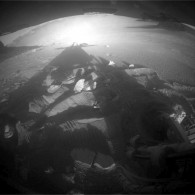
http://qt.exploratorium.edu/mars/opportunity/rear_hazcam/2008-08-01/1R270859212EFF90D8P1314R0M1.JPG ![]()
![]()
![]()
Posted by: centsworth_II Aug 1 2008, 03:42 PM
The silhouette image from Victoria Crater was a musical interlude. This is a crescendo!
Posted by: Stu Aug 1 2008, 08:28 PM
This http://qt.exploratorium.edu/mars/opportunity/forward_hazcam/2008-08-01/1F270853697EFF90D8P1212R0M1.JPGis pretty cool, too... Seems like Oppy's future's so bright she's gotta wear shades... ![]()
Posted by: Floyd Aug 1 2008, 08:51 PM
Seems to me that we have moved forward about a foot at some point--are we free of the mess?
From here http://qt.exploratorium.edu/mars/opportunity/navcam/2008-07-25/1N270223728EFF90C7P1981L0M1.JPGto here http://qt.exploratorium.edu/mars/opportunity/navcam/2008-08-01/1N270853778EFF90D8P1981L0M2.JPG
Posted by: Tesheiner Aug 1 2008, 09:19 PM
> are we free of the mess?
Not yet, IMO.
Based on the data from the pancam web the latest "drive" was done in six steps and the slippage was quite high on all of them: 93%, 93%, 88%, 78%, 89%, and 94%.
Posted by: briv1016 Aug 2 2008, 08:18 AM
According to the latest Flight Director Report Opportunity's wheel stalled.
http://www.jpl.nasa.gov/videos/mer/mer20080731/
Posted by: BrianL Aug 2 2008, 03:17 PM
Is this the same as with Spirit's wheel, that it won't rotate?
Posted by: nprev Aug 2 2008, 04:56 PM
In the past, they've used the word "stall" to indicate a one-time event...i.e., a mechanical component did not respond to a given command. Have to wait & see if it's a persistent problem or not.
Posted by: Stu Aug 2 2008, 05:45 PM
Forgetting the MECA story for a while, here's a colourisation of a beautiful layered rock imaged by Oppy... hope some of you like it ![]()
Posted by: nprev Aug 2 2008, 06:04 PM
What's not to like? Beautiful, Stu, thank you! ![]()
(STILL wanna take a rock hammer to these things & look between the layers. ![]() Guess it's up to my great-great-great, etc. grandsons and/or daughters to do so, though...rats.)
Guess it's up to my great-great-great, etc. grandsons and/or daughters to do so, though...rats.)
Posted by: Sunspot Aug 3 2008, 02:35 PM
At least we have something interesting to look if we're stuck here for the rest of the mission.
Posted by: alan Aug 3 2008, 08:05 PM
Looking back at some of the movements made while they were taking closeups of the wheels I suspect it was the steering motor that stalled.
Posted by: fredk Aug 3 2008, 08:22 PM
Big news from http://www.planetary.org/news/2008/0731_Mars_Exploration_Rovers_Update_Spirit.html
Posted by: jamescanvin Aug 4 2008, 08:41 AM
We had started to discuss the news that Oppy is on her way out in two separate threads, some posts moved to the http://www.unmannedspaceflight.com/index.php?showtopic=5372 thread. Lets continue things over there.
Posted by: briv1016 Aug 11 2008, 05:17 PM
The Pancam site now has there version of the Cape Verde Pan in B&W.
http://pancam.astro.cornell.edu/pancam_instrument/1580B_capeverde.html
Posted by: djellison Aug 11 2008, 07:14 PM
A few of us here probably know just how hard that must have been to pull together, to much kudos to the CCC for managing it ![]()
Posted by: mhoward Aug 11 2008, 10:29 PM
I, for one, didn't even attempt it. Looks very, very good.
Posted by: CosmicRocker Aug 12 2008, 05:12 AM
Whoa! I studied that panorama for quite a while. I realized I was staring too long when the muscles in my http://www.google.com/search?q=define%3Agaping jaws started to cramp.
That was seriously painful. Be warned. ![]()
Powered by Invision Power Board (http://www.invisionboard.com)
© Invision Power Services (http://www.invisionpower.com)
